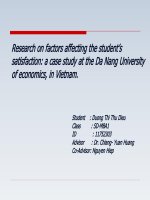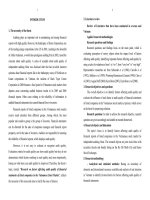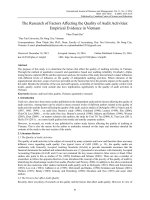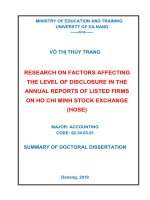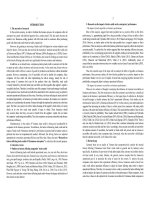research proposal factors affecting tourist loyalty at nam cát tiên national park đồng nai
Bạn đang xem bản rút gọn của tài liệu. Xem và tải ngay bản đầy đủ của tài liệu tại đây (327.61 KB, 44 trang )
<span class="text_page_counter">Trang 1</span><div class="page_container" data-page="1">
MINISTRY OF EDUCATION AND TRAINING
<b>HO CHI MINH CITY UNIVERSITY OF </b>
<b>FOREIGN LANGUAGES - INFORMATION TECHNOLOGY</b>
<b>FACULTY OF TOURISM AND HOSPITALITYSemester 1, Academic Year 2023-2024</b>
RESEARCH PROPOSAL
<b>FACTORS AFFECTING TOURIST LOYALTY AT NAM CÁT TIÊN NATIONAL PARK – ĐỒNG NAI3. Phan Trần Thị Phi Giao - 20DH1302874. Lê Thị Như Quỳnh - 20DH1302055. Trần Thị Bảo Trân - 20DH130324</b>
</div><span class="text_page_counter">Trang 2</span><div class="page_container" data-page="2"><b>PHIẾU ĐÁNH GIÁ BÀI TIỂU LUẬN “PPNCKH TRONG DU LỊCH”1. Thông tin sinh viên</b>
STT Họ và tên MSSV <sup>Tỷ lệ</sup>
hoàn thành <sup>Điểm</sup> 1 Nguyễn Trung Hậu 20DH130099 100
2 Nguyễn Khánh Duy 20DH131241 100 3 Phan Trần Thị Phi Giao 20DH130287 100 4 Lê Thị Như Quỳnh 20DH130205 100 5 Trần Thị Bảo Trân 20DH130324 100
<b>2. Điểm số (theo thang điểm 100)</b>
<i>Chuyên cần Nộp bài thu hoạch đúng thời hạn</i> CLO1 10
<i>Chương 1: Trình bày vấn đề nghiêncứu có 5 phần theo qui định</i>
CLO1 –
CLO5 <sup>20</sup>
<i>Chương 2: Tổng hợp, lược khảođược các nghiên cứu trước, tìm rađược khoảng trống trong các nghiên</i>
</div><span class="text_page_counter">Trang 3</span><div class="page_container" data-page="3"><b>Tổng cộng:</b>
Giảng viên chấm 1 Giảng viên chấm 2
<b> Ngày….. tháng….. năm 2023 </b>
<b>LIST OF TABLES, DIAGRAM AND MODEL</b>
Bảng 2.1: Bảng đề xuất giả thuyết...
</div><span class="text_page_counter">Trang 4</span><div class="page_container" data-page="4"><b>LIST OF TABLES, DIAGRAM AND MODEL</b>
Hình 2.1 Quan hệ giữa chất lượng dịch vụ và sự hài lịng của khách hàng... Hình 2.2 Mơ hình nghiên cứu mối quan hệ giữa thỏa mãn và lòng trung thành... Hình 2.3 Mơ hình đề xuất nghiên cứu...
</div><span class="text_page_counter">Trang 5</span><div class="page_container" data-page="5"><b>TABLE OF CONTENTS</b>
CHAPTER 1: RESEARCH OVERVIEW...1
1. Reason for choosing the topic...1
1.7 Overview of the research situation:...3
1.7.1 Overview of domestic research situation...3
1.7.2 Overview of overseas research...3
</div><span class="text_page_counter">Trang 7</span><div class="page_container" data-page="7"><b>CHAPTER 1: RESEARCH OVERVIEW1. Reason for choosing the topic</b>
Ecotourism today has become a popular and important trend in the tourism industry. With the rise of awareness of environmental protection and the necessity of preserving natural areas, ecotourism is attracting interest from both tourists and destination managers. In the tourism industry, attracting and retaining customers is one of the important factors for business development. Nam Cat Tien National Park in Long An has attracted the attention of many visitors with its beautiful natural landscape and new experiences. However, in order for customers to intend to return, there should be a number of factors that are considered and improved. One of the prerequisite factors is the quality of service. Customers expect dedicated and professional treatment from the staff in the resort. Staff need to be trained in communication skills, understanding of their products and services to be able to meet all customer requirements. The warmth, friendliness and attentiveness of the staff will make an important contribution to creating a positive travel experience for customers. The maintenance and improvement of the quality of leisure activities is another important factor. Nam Cat Tien National Park needs to constantly update new and attractive activities to attract the attention of customers. Organizing interesting activities such as adventures in the forest, walking over suspension bridges or participating in cultural activities will make this tourist area an attractive destination not only for people in the area but also for visitors from far away and especially foreign visitors. Creating a safe and comfortable environment is also indispensable. Ensuring security, hygiene and comfort is important so that customers can enjoy their travel without risks or hassles. In order for customers to intend to return to Nam Cat Tien National Park, business owners (General Department of Forestry, Ministry of Agriculture and Rural Development) need to focus on improving services, improving the quality of recreational activities, creating a safe and comfortable environment, guaranteed infrastructure, ... It is essential to study all these factors to enhance positive perceptions and at the same time suggest ways to improve, to increase satisfaction and return of visitors to Nam Cat Tien National Park. Stemming from the above practices,
</div><span class="text_page_counter">Trang 8</span><div class="page_container" data-page="8">the topic "Factors affecting the intention of visitors to return in Nam Cat Tien National Park" aims to offer solutions and solutions to increase the return of customers and the higher purpose is the loyalty of customers.
<b>1.2. Purpose of research</b>
Get a better understanding of what factors can make a positive impact and maintain customer interest in the destination. This research is not only theoretical but also has practical implications in the development and management of tourist resorts.
One of the purposes to study the factors that influence guests' intention to return is to help resort operators better understand their customers' wants and needs. By identifying these factors, businesses and managers can take appropriate measures to attract and retain customers, thereby increasing revenue and sustainable development for the resort.
Help identify the strengths and weaknesses of Nam Cat Tien National Park. This allows managers and businesses to focus on improving incomplete aspects, thereby enhancing the customer experience and creating higher satisfaction.
Contribute to the development of Vietnam's tourism industry. By better understanding our customers' intentions to return, we can build effective marketing and promotion strategies to attract domestic and foreign visitors. This not only brings economic benefits, but also contributes to building a positive image of the country.
The study of factors affecting visitors' intention to return to Nam Cat Tien National Park is important in improving customer experience, enhancing satisfaction and sustainable development for Vietnam's tourism industry.
<b>1.3. Subjects and subjects of study</b>
<i>Subjects of study: factors affecting the intention of domestic visitors to return to</i>
Nam Cat Tien National Park.
<i>Study subjects: tourists returning to Nam Cat Tien National Park.</i>
<b>1.4. Research tasks</b>
Study documents, theoretical foundations, overview and current status of Nam Cat Tien National Park. Actual survey of current status and customer assessment after visiting Nam Cat Tien National Park. Find out the reasons why customers do not
</div><span class="text_page_counter">Trang 9</span><div class="page_container" data-page="9">return to the resort and offer solutions to that cause. Write reports and offer methods and solutions.
<b>1.5. Research methodology:</b>
- Research methodology: Consult an expert - Research methodology: Data collection
<b>1.6. Scope of research:</b>
- The research paper was conducted in Ho Chi Minh City. The research paper was surveyed from customers who have visited Nam Cat Tien National Park.
- The study will be conducted nearly 3 months from October 7, 2023
- This research paper focuses on the factors affecting the intention of customers to return when coming to Nam Cat Tien National Park.
<b>1.7 Overview of the research situation:</b>
<i><b>1.7.1 Overview of domestic research situation</b></i>
<i>According to Nguyen Van Thich (2021), Factors affecting Binh Quoi's intention to</i>
<i>return to tourist destinations of domestic tourists have come to a conclusion affecting</i>
the intention to return as shown through the image of the tourist destination, natural and cultural environment, reasonableness of prices, tourist infrastructure, accessibility, local cuisine, entertainment services, local people.
<i>According to Lin et al. (2007), Influence of destination image, emotional value on</i>
<i>visitor satisfaction and loyalty: Dalat city case study, tourist satisfaction positively</i>
influences the factor of returning to the attraction.
<i>According to Nguyen Tien Thanh (2021), The relationship between the image of Da</i>
<i>Nang destination and the intention of domestic tourists to return. The emotional factor</i>
partly influences the intention of visitors to return when visiting the attraction.
<i><b>1.7.2 Overview of overseas research</b></i>
This topic has been researched by many authors, some factors have been mentioned and the authors have proposed some more elements to expand the topic.
</div><span class="text_page_counter">Trang 10</span><div class="page_container" data-page="10">According to M-K's customer satisfaction model. Kim et al argue that customer satisfaction consists of six basic components: service quality, service price, brand image, advertising promotions, added services, customer service.
According to research by Hossain, M. A., Chowdhury, M. R., & Jahan, N. (2017) suggests that the factors used to determine consumer satisfaction and loyalty are: price factors, service quality, customer care, brand image.
<i><b>1.7.3 Conclusion</b></i>
Thereby, the authors agree with factors such as service quality, service price, tourist attraction image, natural environment, infrastructure, local cuisine, entertainment services and give some other factors that can affect customer loyalty such as brand reputation, perceived value.
<b>CHAPTER 2: THEORETICAL FOUNDATIONS AND RESEARCH MODELS</b>
At the beginning of the team's paper, the authors will bring some theoretical foundations from various experts in fields related to tourism, market marketing, hospitality and services to clarify the basic concepts and thereby inherit the research model that the team proposed in this research paper for that purpose is to prove that the research model of the group is good in all aspects, from summarizing the purpose of the group and offering some best solutions to solve some problems that the business establishment has been facing, in order to improve some service quality and give customers a service experience as expected; theirs and moreover, the return to use the services of the business is the goal that the team set for the research paper, the loyalty of customers to tourism products in the national park.
These will be some theoretical bases that the authors have integrated and researched to form a research model of customer loyalty to the research subject that is customer loyalty. The goal of the authors in this program is to clarify the concept of factors affecting customer loyalty including such as service quality at the destination, affordable price, brand reputation of the business, brand awareness if meeting these factors will achieve customer satisfaction, And when the business has achieved customer satisfaction, it is certain that the ability of customers to return will account
</div><span class="text_page_counter">Trang 11</span><div class="page_container" data-page="11">for quite a high rate, and the higher goal is the long-term commitment of customers to the product.
<b>2.1. Theoretical basis </b>
<i><b>2.1.1. Concepts </b></i>
In recent years, when tourism products are more and more diversified in the market with many different price segments aimed at each customer, that business aims to attract, find new customer files and maintain relationships between customers who have used tourism products. However, the return rate of customers for travel products they have used is relatively unsatisfactory, customers are always looking for new products and services to solve problems that satisfy their needs. So to overcome this, some researchers have come up with a lot of concepts about each problem such as:
<i>2.1.1.1. The concept of service quality </i>
One of the first factors affecting the return rate of customers or establishing customer loyalty to the tourism products provided by that enterprise, the quality of service will play a significant part in influencing the feeling of customers, thereby shaping the decision of returning customers in the future.
According to the International Organization for Standardization ISO defines as relevant factors of service quality: "Quality is the ability of the set of characteristics of a product, system or process to meet the requirements of customers and stakeholders." The author, according to Parasuraman, Zeithaml and Berry (1985), introduced the notion that service quality can be seen as the gap between customers' expectations and their perceptions after using the service.
Service quality is also considered the process by which the supplier must ensure the satisfaction of all legitimate products and service needs, requirements and expectations of consumers, at an acceptable price according to the World Tourism Organization.
In addition to the researchers' concept of service quality, there is a relationship between service providers and their expectations and perceptions after customers have used the product. In order to meet the research objectives of the group, the team observed and concluded as follows. In addition to the relationship as listed by the above authors, there will be some objective factors that the authors also recognize
</div><span class="text_page_counter">Trang 12</span><div class="page_container" data-page="12">some factors affecting service quality such as according to Nguyen Xuan Thanh (2015), Impact of destination image on customer loyalty: In the case of Nghe An tourist destination, PhD thesis, Hanoi University of Science and Technology, service quality is influenced by factors such as destination image, natural environment, infrastructure, local cuisine, entertainment services.
<i>2.1.1.2. The concept of brand reputation </i>
According to Thuong Cong magazine, they show that customers often rely on reputation and brand to choose products. Because when it comes to product brands, customers usually know the style/quality/price of each brand, from which they can easily choose their favorite products.
<i>2.1.1.3. The concept of emotional value of customers</i>
According to the author Sheth et al. (1991), emotional value refers to the emotions and happy and sad states of customers when using or experiencing services/products at businesses. In addition, for the landscape at the tourist attraction, Williams & Soutar (2009), for the point of view, emotional value is assessed to create a sense of safety and enjoyment to stimulate the discovery of customers at a certain attraction.
<i>2.1.1.4. The concept of customer satisfaction</i>
After meeting the concepts that the author team has drawn from many different authors about service quality, brand image, price and brand reputation. The authors would like to mention some conceptual bases of customer satisfaction in the tourism industry.
For a business that has ensured the above factors that the authors have presented or more, the higher the rate of meeting customer satisfaction will be. Weber (1996) argues that customer satisfaction is a fundamental element of customer marketing theory that has an important influence on a customer's future purchase intent, either through distribution or word of mouth (WOM).
<i>2.1.1.5. The concept of customer loyalty </i>
The last concept that the authors want to mention in the research paper is customer loyalty in the tourism industry. After meeting the expectations and expectations of customers, businesses will get a part of customer satisfaction. Thereby
</div><span class="text_page_counter">Trang 13</span><div class="page_container" data-page="13">forming customer loyalty and increasing the return rate for used tourism products in the future. Because customer loyalty is critical to the success of any organization.
According to Oliver (1997), loyalty is a behavioral bond directed to future purchases of products or services. Because the rate of return of visitors to a certain tourist destination that they have visited or not is very difficult to predict.
Besides, customer loyalty is also shown through the decision of customers whether to return to use the service and whether they are willing to recommend products at that business to customers or not. According to Chen and Tsal's research (2007) và Oppermann (2000) cũng đã đề cập như sau: “mức độ của lòng trung thành đối với một điểm đến được thể hiện qua ý định quay lại và sẵn sàng giới thiệu nó cho người khác”.
<b>2.2. Research hypotheses and models</b>
<i><b>2.2.1. Research hypotheses </b></i>
<b>The relationship between visual elements of tourist spots, naturalenvironment, infrastructure, local cuisine, entertainment services and servicequality </b>
<i>Yumi Park and David Njite studied the relationship between Destination</i>
Imagery and Traveler's Intended Behavior in Jeju Island, South Korea. In this study, Destination images are measured through 04 factors: (1) Environment, (2) Attractiveness of the destination, (3) Value for money, (4) Climate. The authors developed a research model to examine the relationship between the components of Destination Imagery to Visitor Satisfaction, which in turn influenced Traveler Intent to Return.
<i>Asuncion Beerli and Josefa D. Martín conducted research on the influence of</i>
travelers' individual characteristics on different components of travelers' perceptions of destination images. Factors that affect visitors' perception of destination image include: Natural environment, Infrastructure, Tourism infrastructure, Entertainment services, Cultural, historical and artistic values, Political and economic factors.
<i>Tun Thiumsak and Athapol Ruangkanjanases studied the factors influencing</i>
international tourists returning to the Thai capital, Bangkok. This study, although referring to international tourists, is a theoretical basis and builds a number of factors
</div><span class="text_page_counter">Trang 14</span><div class="page_container" data-page="14">that affect the intentions of domestic tourists. The results of the study identified five factors that affect foreign visitors' intention to return to Bangkok, Thailand, including: Satisfaction of destination attributes, Overall satisfaction, Perception of attractiveness of the destination, Overall image of the destination, Tourists' motives.
<i>According to Nguyen Xuan Thanh (2015), Destination image impact oncustomer loyalty: The case of Nghe An tourist destination, PhD thesis, HanoiUniversity of Science and Technology</i>
Destination images
<i>H1: The image of the destination is the impression, belief and general</i>
<i>simulation of the destination that wants to target customers. Or it is also</i>
the attributes of associating the brand of the travel destination with identifying characteristics that help customers have an overview of that travel destination.
Natural environment
<i>H2: The natural environment is elements that occur in nature but do not</i>
<i>have an impact from humans. In tourism, the natural environment</i>
includes rivers, mountains, ponds, lakes, forests, deserts, weather,...
<i>H3: Infrastructure is a component that has a significant impact on thequality of services. Infrastructure is a fairly transparent tool for most</i>
people, within time and space, tied to familiar structures such as the power grid, water, the Internet, and airlines. The infrastructure includes general infrastructure (medical services, telecommunications,...) and tourism infrastructure (such as houses, restaurants, hotels, tourist centers,...).
</div><span class="text_page_counter">Trang 15</span><div class="page_container" data-page="15">Local cuisine
<i>H4: Food has become an increasingly important factor in the tourismindustry, which will help improve food service as well as increasecustomer satisfaction. For destination food suppliers, it is necessary to</i>
expand the knowledge of tourists' food culture (including eating habits, tastes, customs,...) to make the food fit the habits of tourists.
Entertainment services
According to the Oxford Dictionary, leisure refers to time spent doing what you enjoy when you're not working or studying. Entertainment is
<i>also defined as a film/musical,... used to entertain people. H5:</i>
<i>Recreation includes outdoor activities, adventure activities, shoppingas well as nightlife.</i>
<b>Table 2.1: Hypothesis proposal table</b>
<b>The relationship between emotional value and visitor satisfaction andloyalty. </b>
It is possible that emotional value will also have an impact on customer behavior decisions, as according to Sheth &; colleagues (1991). When visitors visit with a positive emotion towards the tourist destination, this will lead to the satisfaction of visitors and the authors that the authors have consulted also cite the relationship
</div><span class="text_page_counter">Trang 16</span><div class="page_container" data-page="16">between emotional value, which is a good catalyst to positively impact the experience and satisfaction of visitors. (Gallarza & Saura, 2006; Hung & Petrick, 2012)
Customer satisfaction with a tourist destination is a positive state that affects the perception and behavior of customers. Many researchers have argued for verifying the positive impact of customer satisfaction on their loyalty (Chen et al., 2007; Pham &; Kullada, 2009). In the tourism industry in particular, there are also various studies to verify the positive relationship between customer satisfaction and loyalty, such as Yoon & Uysal (2005); Lee (2009); Hung & Petrick (2012); Horng et al. (2012).
Based on some of the above theories, the authors have concluded and would like
<i>to propose the following hypothesis: H6 Emotional value is a positive catalyst for</i>
<i>customer satisfaction and loyalty. </i>
<b>The relationship between Service Quality and Customer Satisfaction in thetourism industry. </b>
To know a good product, high reliability, businesses will have to prove that their service quality will meet the expectations and expectations of customers. Because service quality can be said to be the first measure in deciding to use tourism products for that business to provide in the market, if a tourism business provides products and services that meet the criteria set by customers, this is the factor determining satisfaction as well such as achieving customer satisfaction. According to Oliver (1993), the quality of service affects the level of customer satisfaction. This means that service quality is determined by many different factors, which are part of the determinant of satisfaction (Parasuraman, 1985, 1988).
According to Cronin & Taylor (1992), the test and conclusion is that quality of service leads to customer satisfaction. Service quality is the first factor of satisfaction and the main factor affecting satisfaction.
Based on the above theoretical bases, the authors have concluded and proposed
<i>the hypothesis as follows: H7 service quality is the top prerequisite factor leading to</i>
<i>customer satisfaction. </i>
</div><span class="text_page_counter">Trang 17</span><div class="page_container" data-page="17"><b>The Relationship Between Price and Customer Satisfaction in the TravelIndustry </b>
According to Cronin and Taylor (1992), customers do not necessarily buy the highest quality products or services, they will buy the products and services that give them the most satisfaction. Therefore, service quality does not affect the price, but it will affect customer satisfaction.
According to Patterson et al (1997), with the fierce competition of the current industry, customers' perceptions of products and services, price and customer satisfaction are closely related. Without mentioning price, satisfaction research would be inaccurate.
According to Kaura (2012) Price is an important factor affecting customer satisfaction. According to Andaleeb And Conway (2006) In a competitive environment, customers always make price comparisons between suppliers. This becomes even more important for products with a clearly standardized nature. Various studies show a link between product and service price and customer satisfaction (Andaleeb And Conway, 2006; Dharmalingam and Kanna, 2011; Kaura, 2012), in which feeling good about price creates customer satisfaction.
Based on the above theories, the authors found that it does not matter whether it is expensive or cheap, but depending on the feelings of customers, when customers feel reasonable service prices, they will be satisfied and satisfied. The authors would
<i>like to propose the following hypothesis: H8 Price is a cause of customer satisfaction.</i>
<b>The relationship between Brand Reputation and Customer Satisfaction inthe Tourism Industry </b>
According to Makanyeza and Chikazhe (2017), the brand image is the orientation, clear development plan, credibility in the eyes of customers, ethics when doing business and keeping trust in customers.
Brand reputation can represent products associated with the brand (Truong, McColl, & Kitchen, 2009). Alden, Steenkamp, and Batra (1999) argue that consumers
</div><span class="text_page_counter">Trang 18</span><div class="page_container" data-page="18">tend to perceive consumption of prestige brands as indicative of social status, wealth, or power because prestigious brands are not purchased often and are strongly related to an individual's social image
According to Han et al. (2020), reputable brands differ from non-reputable brands in a number of ways that can influence consumers' motivation for purchasing decisions. For example, to enhance their social status and self-expression. Compared to non-reputable brands, reputable brands not only provide intangible benefits to consumers, but also create value for consumers through asserting their position and getting attention. In addition, numerous consumer studies demonstrate the decisive role of self-improvement in consumer preference for brands (Fournier, 1998; Han et al., 2020; Thomson, Mac Innis, & Park, 2005). Therefore, brand reputation has a synergistic impact on consumers' brand recognition
Based on the above theories, the authors found that the reputation of a tourism business shows the popularity and popularity of the business, reflecting the satisfaction and reliability of customers for that business. The authors have inherited
<i>and hypothesized as follows: H9 Prestige is an important factor to help customers</i>
<i>choose products and services of the business.</i>
<b>The relationship between Customer Satisfaction and Loyalty in the Tourismindustry. </b>
To prove whether the relationship of satisfaction affects customer loyalty, according to Curry and Sinclair (2002), if a business provides a quality of service that meets customer expectations, there will be customer satisfaction and vice versa. From there, customer loyalty is formed. Research by Wicks and Roethlein (2009) shows that if businesses increase satisfaction, it will increase customer loyalty to the tourism products they provide. In addition, the increase in loyalty leads to a positive factor for travel businesses that is an increase in the number of return purchases and a decrease in the percentage of customers to other businesses.
In a study by Nguyen Thi Mai Trang (2006) also pointed out that service quality is an important factor to satisfy customers, as well as increase their loyalty.
</div><span class="text_page_counter">Trang 19</span><div class="page_container" data-page="19">According to Giao and Ai (2020), which has also proven the relationship between service satisfaction and customer loyalty, this research model has shown that when customer loyalty is met, they will show loyalty through the behavior of buying a product at a used supplier.
Based on the above theories of some authors, the authors would like to
<i>propose the following hypothesis: H10 Satisfaction affects customer loyalty.</i>
<i><b>2.2.2. Research model </b></i>
From the hypotheses that the authors have proposed for the relationships and correlations between factors that the authors have inherited from many research papers on the loyalty of tourists about the company's products.
The authors would like to propose the following research model:
Figure 2.2 Model studying the relationship between satisfaction and loyalty
</div><span class="text_page_counter">Trang 21</span><div class="page_container" data-page="21"><b>CHAPTER 3: RESEARCH DESIGN</b>
In the content of chapter 3, the authors are presented in detail about the methods and processes in the research process. From there, from the perspective of students, the authors will adjust and evaluate the scales, theories, and methods that the authors have obtained through data processing.
<b>3.1 Study design</b>
<i><b>3.1.1 Research process</b></i>
During the research process, the first thing that needs to be determined is based on data about the factors that affect customer loyalty about a product in the long run and extend the life of a product. In the following, the authors would like to present the research process that the authors have carried out throughout the measurement research process are qualitative research and quantitative research.
The research process of the author team will present in specific steps as follows:
<b>Table 3.1. Summary of research steps</b>
<b>methodology<sup>Data Collection Techniques</sup><sup>Execution time</sup><sup>Location</sup></b>
1 Qualitative <sup>Expert interviews, group</sup>
discussions Oct – 16 HCM City 2 Quantitative Surveys through surveys Nov – 7 HCM City
<i>Source: Author Synthesis</i>
<i><b>3.1.2 Research methodology</b></i>
<i>Step 1: Qualitative research</i>
</div><span class="text_page_counter">Trang 22</span><div class="page_container" data-page="22">The first step in this research method is to find theories and synthesize materials from the textbooks, relevant domestic and foreign studies that have been published by the authors before, helping the author group inherit the approach to solving problems of previous authors and at the same time help the group of authors gathered review the observed factors and variables, thereby building a preliminary research model for the trial investigation process with experts. However, there are still some factors and variables observed that affect this scale, because these factors and scales are developed in developed countries, leading to differences in culture and speed of tourism economic development compared to Vietnam's tourism economic market. At the same time, the model and legacy scales of the authors are integrated from research articles from domestic and foreign authors related to customer loyalty and customer satisfaction, but the observed variables and factors are not really consistent with the research model of the proposed author team.
Therefore, the authors conducted qualitative research through expert interviews with the purpose of appraising and adjusting the research model to build a survey for quantitative research, the authors conducted an interview and discussed with 1 expert researcher in the field of tourism about the impact factors touch customer loyalty.
The next step is to conduct a group discussion of 5 people who have used the services of Nam Cat Tien tourist area who are currently studying, working and living in Ho Chi Minh City. The purpose of the group discussion is to check and re-evaluate the use of words in each question, each measurement variable to ensure that the subjects interviewed through the questionnaire understand correctly and clearly. The participants in the group discussion are those who have had time to experience all the services at Nam Cat Tien tourist area.
The authors carry out qualitative research for the purpose of which is to supplement and adjust the scales, as well as to verify the clarity of words, the ability to speak as well as the duplication of statements in the scale so that it can be adjusted accordingly. Therefore, through this result, the authors have adjusted the research model and scales to suit the loyalty of customers in Nam Cat Tien tourist area.
</div>
